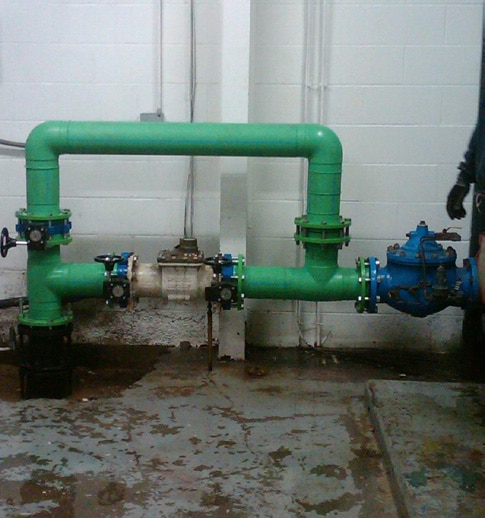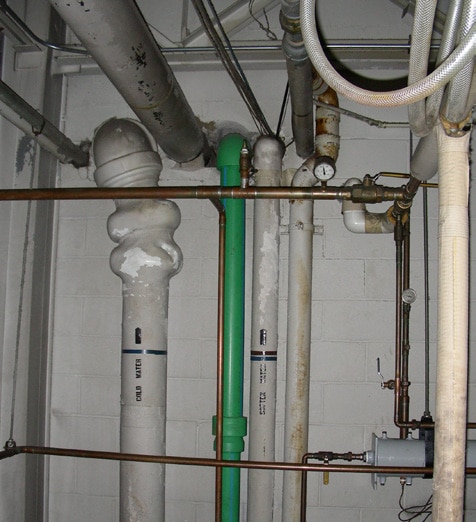AQUATHERM HELPS DRY UP INDUSTRIAL LAUNDRY FACILITY’S LEAK WOES
Corrosion- and rust-proof, aquatherm held up so well over a 3-year period the facility is using it on their main line.
The Challenge
Aggressive process water had consistently rusted through the existing Schedule 80 steel.
The Solution
Corrosion- and rust-proof, aquatherm held up so well over a 3-year period the facility is using it on their main line.
A relatively new-to-North-America piping solution dries up industrial laundry facility’s leak woes.
Located in the Cincinnati suburb of Covington, Kentucky, Tri-State Health Care Laundry provides its services to several facilities in Ohio, Kentucky and Indiana. Featuring 52-foot-long washing machines and 12-foot-tall dryers with 8-foot tumblers, the facility manages to churn out crisply washed linens, uniforms, and other laundered items on a massive basis.
In keeping with the largesse of the process, the facility also has a tremendous amount of piping – well over 1,500 linear feet. Coursing through all that piping is an enormous amount of process water – almost 1 million gallons a month. Of course the water, detergents, and other chemicals are extremely corrosive.
In fact, the existing schedule 80 galvanized steel piping was rusting from the inside out. The problems were so severe that for an hour once a week the facility had to flush the pipe by letting a ¾-inch line run full bore to flush the system in an effort to reduce the corrosion. In the summer of 2008, Tri-State decided to repair some pipe sections that had lost the battle with the caustic process water.
CORRECTING THE CORROSION CONUNDRUM
 The two sections of leaking four-inch pipe ran along the Tri-State’s ceiling about 30 feet off the facility floor. At the street, the water enters the piping at roughly 110 psi and in the building it runs at ambient temperature and about 80 psi.
The two sections of leaking four-inch pipe ran along the Tri-State’s ceiling about 30 feet off the facility floor. At the street, the water enters the piping at roughly 110 psi and in the building it runs at ambient temperature and about 80 psi.
Located in nearby Elsmere, Kentucky, MarkCo, Inc. Plumbing and Building Services, has been providing Tri-State with backflow testing for roughly the last decade and ongoing plumbing maintenance and support for the last six years. MarkCo’s foreman, Gary Kentley presented an innovative solution to the corrosion conundrum.
While a traditional solution such as roll grooved pipe was briefly considered, installing that type of pipe from a scissor lift was going to exceedingly difficult. Kentley had been introduced to aquatherm’s polypropylene-random (PP-R) piping by Zak Schultz with the local aquatherm representative, StreamKey Engineered Plumbing and Waste Water Solutions (Cincinnati). Kentley immediately identified the Tri-State repair as a perfect application for aquatherm.
“The first reason that aquatherm made sense for this job was that it is so much lighter than steel. Three joints were necessary to put the run of pipe in, and it would have been six joints if we had used galvanized steel because of its weight,” Kentley said. However, since the galvanized steel had already experienced serious corrosion problems, aquatherm was selected.
aquatherm, which is manufactured in Germany, is so durable and leak- and corrosion-resistant that it’s used extensively in acid waste and chemical process applications. It has been proven globally for 35 years, but is relatively new to North America.
The heat fusion process used to join aquatherm pipe bonds both sides of a joint into a single, homogenous material without the use of flames, chemicals, or mechanical connections. Once fused, pipes and fittings have the same physical properties, thus eliminating systematic weaknesses that can be caused by introducing different materials into the joint in other types of piping systems.
Additionally, aquatherm provides a 10-year warranty on pipe and fittings with a product liability valued at 9 million Euros for personal injury and 4.5 million Euros for property damage per event, to aquatherm-trained and certified installers.
NO MORE FLUSHING
 Tri-State’s facility manager Steve Johnson wasn’t concerned about what piping material would be used for the repair; he simply wanted the line repaired so that they didn’t have to keep flushing it and so that it didn’t leak. “The facility manager basically told me, if it’s faster and cheaper – do it,” Kentley recalled.
Tri-State’s facility manager Steve Johnson wasn’t concerned about what piping material would be used for the repair; he simply wanted the line repaired so that they didn’t have to keep flushing it and so that it didn’t leak. “The facility manager basically told me, if it’s faster and cheaper – do it,” Kentley recalled.
StreamKey’s Schultz trained the MarkCo employees on the fusion welding technique. However, since they had used polypropylene for acid waste piping the Tri-State installers were already familiar with fusion welding and the training went quickly.
Four-inch aquatherm blue SDR-11, which is designed specifically for industrial, HVAC, and compressed air applications, replaced the steel. Made from over 98.5% PP-R, blue, is particularly well suited for these applications because of the material’s natural insulation properties: an R-value of 1 to 1.5 depending on pipe size and SDR.
Depending on the application’s minimum operating temperatures and maximum humidity levels, blue can be installed without insulation and still produce no condensation during normal operation. This was another big benefit that piqued Tri-State management’s interest in the beginning.
The first repair was a 21-foot section that was accessed via a scissor lift. Tri-State installers cut out the existing sections and replaced them with blue using aquatherm flanges, couplings, transitions, and also some steel flanges.
MarkCo did as much fabrication of the joints on the ground as possible, fusing the flanges and the first piece of pipe and its coupling, then welding it into place via the scissor lift. The second repair was a 30-foot section in a corner of the facility and was done via ladders and an access through a cinder block wall.
There was one joint involving a 90-degree fitting that was buried in the wall, which made the repair a bit challenging. Getting the aquatherm four-inch welding jig into proper position was difficult. “We used flanges on both ends, and it was a bit short, so we had to move all the hangers, and then there was still a small gap between them so we had to massage it by hand to get it close enough to fuse,” Kentley said. “However, the installation went smoothly considering it was a new product and a retrofit,” he added.
NO LEAKS, NO DRIPS, NO WORRIES
Throughout the repairs, there were no leaks at all, and Kentley explained that the four-inch joints were typically completed in only 3-4 minutes, whereas it would have been 15 minutes per joint for steel. This considerable labor savings added, up, Kentley said. “Price-wise aquatherm was comparable to steel, or maybe a bit cheaper, but labor-wise, it was a whole lot cheaper. We look to use it wherever we can now.”
More than a year later, the repairs are holding up perfectly, and Tri-State now has a go-to piping option. In fact, life there would probably be a lot easier if all the facility’s piping was PP-R.